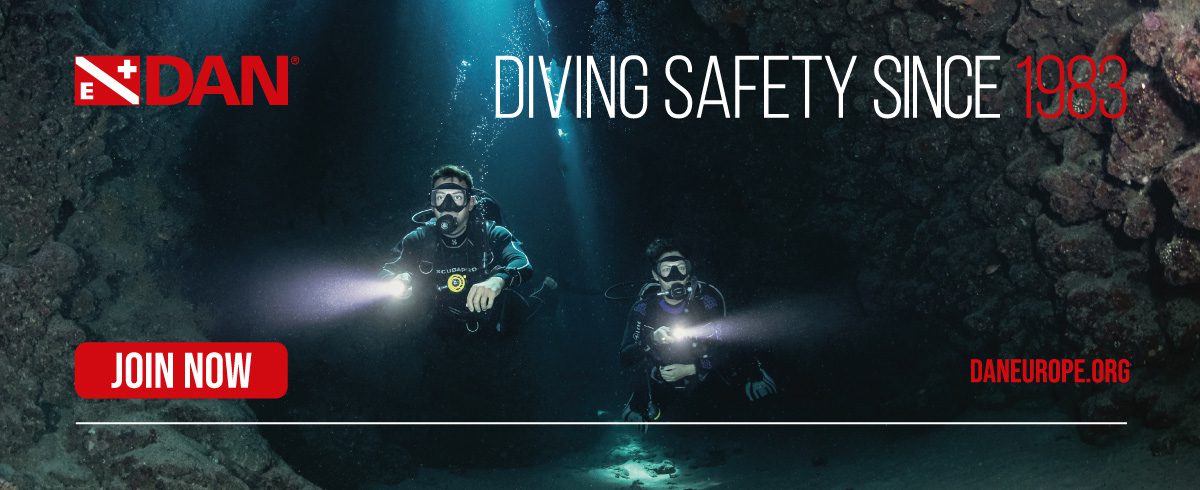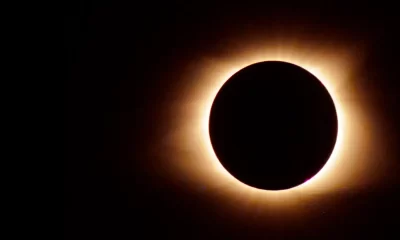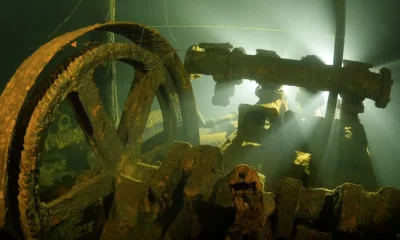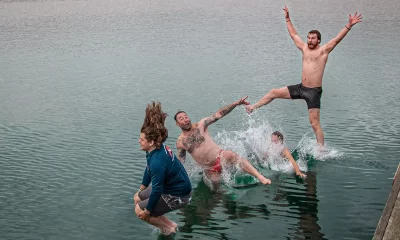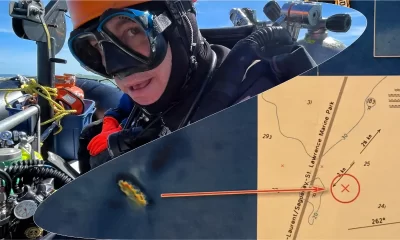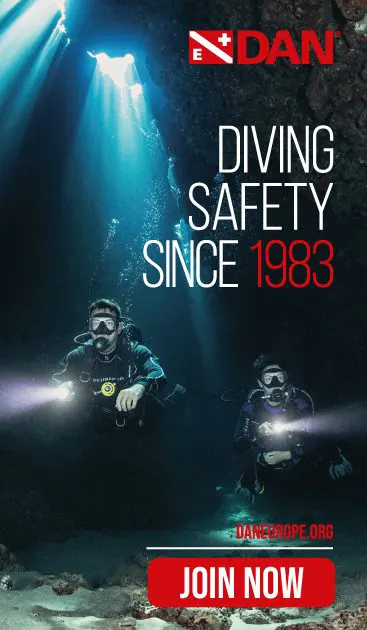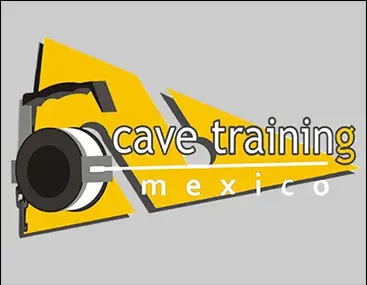Exploration
A Conservator’s Reflections on the Andrea Doria
This month marks the 65th anniversary of the sinking of the SS Andrea Doria, once described as the “Mt. Everest of wreck diving.” Here veteran wreck diver/collector John Moyer, who was granted an “Admiralty Arrest” over the Doria in 1993, in order to recover its famed Guido Gambone ceramic art panels, recounts the key milestones of the deteriorating wreck, and his efforts to display her historical artifacts.
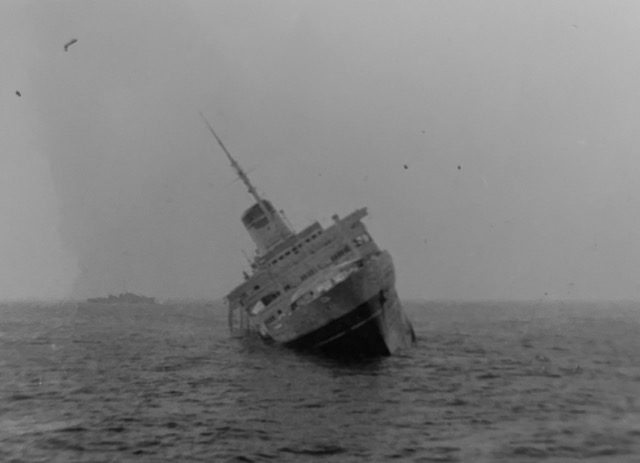
By John Moyer
Header image of the sinking of the Andrea Doria July 27, 1956, and other photographs courtesy of John Moyer unless noted.
This year marks the 65th anniversary of the sinking of the Italian liner SS Andrea Doria. During the four years the ship sailed between Italy and New York, she was known as a “Floating Art Gallery.” The aftermath of the collision with the Swedish vessel, Stockholm, 80 km/50 miles south of Nantucket Island off the coast of Massachusetts, was described as the greatest sea rescue in history.

Peter Gimbel was the first diver on the wreck on July 27, 1956—the day after it sank—and he returned the following year to photograph it again for Life Magazine. Capt. Dan Turner took a team of divers to the wreck aboard his ship the Top Cat in 1964. Turner blew a hole in the Promenade Deck and recovered the life-sized bronze statue of Admiral Andrea Doria from the First Class Lounge. Unable to free the statue’s base from the deck, they cut it off at the ankles with hacksaws. Four years later, Italian film producer Bruno Vailati led an expedition to survey the wreck and determine if it could be refloated. The Fate of the Andrea Doria(English title) was comprised of footage taken throughout the expedition team’s 21 dives, and the journey inspired Stefano Carletti’s classic book, Andrea Doria-74.
Gimbel returned to the Doria in 1975 to test his theories on exactly what caused the ship to sink; this research inspired his film, The Mystery of the Andrea Doria. He discovered that the Doria had sustained massive damage to it’s hull when the Stockholm hit. During his next expedition in 1981, Gimbel and his team salvaged the ship’s safe, which he opened later that year on live TV. Various other teams also investigated (or attempted to investigate) the wreck during this time period. Some just explored the sunken vessel, some returned home empty-handed, and some didn’t even make it to the wreck site.
I remember hearing about the Andrea Doria for the first time in 1975 at a shipwreck artifact show in Brielle, New Jersey; the Eastern Divers Association orchestrated the event. I met some divers there who told me about a wreck they described as the “Mt. Everest of Diving.” She was a massive 213 m/699 ft-long passenger liner lying on her starboard side, 74 m/241 ft in the cold, dark North Atlantic. That area of the ocean is known for frequent storms, rough seas, and strong currents. The divers said they often had to pull themselves hand-over-hand down the anchor line, fighting to reach the bottom. Visibility averages about 8 m/26 ft, so they had to be careful not to get hung up in the commercial fishing nets that had snagged the exterior of the wreck. Because she is on her side, it’s easy to become disoriented when penetrating the wreck. The interior is a confusing maze of ceilings that are now walls, walls that are now floors, and stairwells that run sideways. It is filled with silt; the water may be clear when you swim in, but picking up an artifact decimates the visibility, so divers often have to feel their way out. Steel cables and wires hang down, and divers can easily become entangled. When I left that show, I knew I wanted to see the Andrea Doria for myself.
My First Doria Dives

In 1982, I dived the wreck for the first time with a small group of divers on a chartered boat. We anchored at the forward end of the Promenade Deck, and I made three dives exploring the area. My first finds were two silver jewelry boxes and a brass-framed window. The next year, we began diving into the ship’s first class dining room where we found piles of china dishes and glassware. In 1985, a dive team and I spent a week on the wreck and recovered the 68 kg/150 lb brass bell from the ship’s aft steering station.
After that 1985 trip, I began my serious research into the ship and collected everything I could find related to the Andrea Doria. I traveled to Italy to meet with the engineers at Ansaldo Shipyard—who had designed the ship—and the Italia Line officers who were onboard the night of the collision. I also corresponded with Bruno Vailati to get his insight into diving on the wreck. Between 1985 and 1991, we made many trips out to the site, exploring new areas of the wreck and recovering any artifacts we found.
In 1992, based on information I had received from Italy, Billy Deans and I began searching the bow of the wreck for the ship’s main bell. We entered through a hatch, swam along a corridor, then up a hallway to the room where I was told it was stored. When I pried opened the door, I found the room was filled with about 1 m/3 ft of silt and debris. Later that year, I took a team of 15 divers and crew aboard the R/V Wahoo and spent a week cleaning out the room with an airlift. Unfortunately, we did not find the bell.

During the winter of 1992-1993, Rinaldo Negri, who had helped design the Andrea Doria, sent me a book with a photo of the ship’s Wintergarden Lounge; the photo captured the lounge’s large wall panels inlaid with ceramic sculptures created by Italian artist Guido Gambone. I was able to match that photo with the ship’s plans and determine exactly where the works of art were on the ship. Billy Deans and I dove into the Wintergarden and found that two panels had fallen from their mountings and were lying deep inside the wreck. Later that summer, I returned on the R/V Wahoo, this time with a team of 20 divers and crew, to recover the panels. Over a period of four days, working in near zero visibility at a depth of 61 m/199 ft, the team rigged each 454 kg/1,000 lb panel with inflatable lift bags and floated them to the surface.


Prior to the expedition, my attorney filed legal papers in the US District Court in Camden, New Jersey. Judge Joseph Rodriquez granted an Admiralty Arrest, asserting the court’s jurisdiction over the Doria, and appointed me custodian of the wreck. I was required to attach the signed arrest papers (inside a sealed container) to the wreck. Later that year, we again appeared before Judge Rodriquez. We argued that, although insured by an Italian consortium, the underwriters had made no attempt at salvage in nearly 40 years; therefore, they had abandoned the wreck. The court agreed and named me Salvor-in-Possession. This gave me exclusive salvage rights, clear title, and ownership of anything we recovered. I did not want to shut the wreck down from recreational divers and have allowed them to continue to dive it, to photograph, and to recover small artifacts. In his ruling, the Judge stated: “Moyer’s independent research and archeological documentation of salvage efforts indicate a respect for the Andrea Doria as something more than just a commercial salvage project.”

Displaying The Doria
From the very beginning, my intention was to collect certain artifacts from the wreck and as many items related to the ship that I could find. I wanted to create an Andrea Doria exhibit to tell the story of what some call the most beautiful ship to ever sail. I have put on dozens of temporary exhibits and displays over the years and hope someday to have a large permanent exhibit. The general public has always been very interested and pleased to see what we have recovered. I am also working closely with Andrea Doria survivor Pierette Simpson. She is the author of Alive On The Andrea Doria and produced the award winning film Andrea Doria: Are the Passengers Saved?
We have held many events, participated in film screenings together, and have ridden in the New York City Columbus Day Parade (along with other survivors and Ted Hess, lead diver of Gimbel’s 1981 expedition). At the end of the parade, there was a ceremony where Pierette rang the Andrea Doria bell in memory of the souls who lost their lives in the sinking. We are currently working with The Noble Maritime Collection in Staten Island, New York on an exhibition which will open late spring 2022.


The inevitable decay of sunken ships is slow and most often unobserved. The sinking of the Andrea Doria produced a wreck of very unusual characteristics. Due to newsreel camera planes circling overhead, it became world famous, and its final resting place is accessible to divers. When Peter Gimbel first visited the wreck in 1956, he saw no obvious damage to the ship. Since then, divers have been reporting major decay events on the wreck. The wheelhouse was still intact when the Italian dive team filmed it in 1968, but it was gone by 1973. The funnel, mast, and top three decks of the superstructure had fallen off by the time I first dove it in 1982. We used the port side bridge wing as a landmark until it fell off sometime in the early 1990s. The Wintergarden was completely intact when we recovered the Gambone sculptures in 1993, but it totally collapsed only two years later.

Later in the 1990s, we noted cracks in the hull and the Boat Deck, Upper Deck, and Foyer Deck had started to slide downward to the sea floor. A recent multibeam sonar scan by the University of New Hampshire showed that the cracks have expanded and that the hull has entered its final stage of the flattening process.
Someday the Andrea Doria will be an unrecognizable pile of debris on the bottom of the sea. Fortunately, we have been able to rescue many historically important artifacts and unique works of art before they were lost forever.
Additional resources
InDepth: Stefano Carletti: The Man Who Immortalized The Wreck of the Andrea Doria By Andrea Murdock Alpini
Alert Diver: Remembering the Andrea Doria by Michael menduno
Diver: Doria Tipped The Scales by Michael Menduno
John Moyer’s first dives were in 1970, and he began diving on shipwrecks in 1975. He has made thousands of dives on wrecks in the US, Canada, Great Britain, Mexico, and the Caribbean. He has dived on the liner RMS Empress Of Ireland, Ironclad Monitor, Light Cruiser USS Wilkes-Barre, and was one of the first Americans to dive on the WW1 German fleet in Scapa Flow, Scotland.
He has a degree in Biology from Stockton University, a USCG 100 Ton Master License, and worked as an Instructor at the Dive Shop of New Jersey and Key West Divers. Moyer is a member of the Atlantic Wreck Divers Dive Club and is the recipient of the prestigious Pioneer of Northeast Diving Award. He has appeared on the History Channel, A&E Network, and Dateline NBC. He is co-author of “The Decay of the Andrea Doria,” published by the Society of Naval Architects and Marine Engineers, and he appears in the docufilm Andrea Doria: Are the Passengers Saved?








